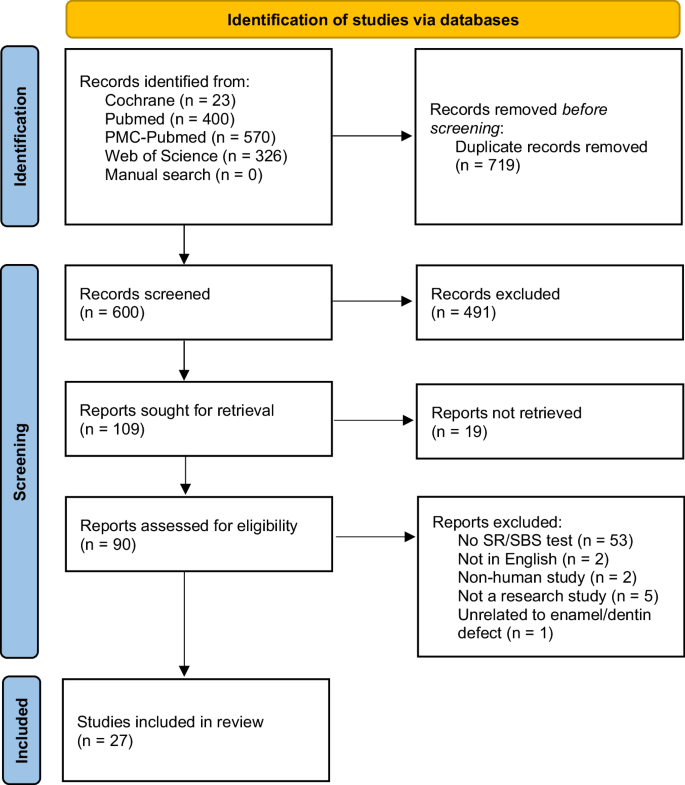Pretreatments to bonding on enamel and dentin disorders: a systematic review
Q3 Dentistry
引用次数: 0
Abstract
This systematic review focuses on structural anomalies of enamel and dentin such as fluorosis (F), molar-incisor hypomineralization (MIH), amelogenesis imperfecta (AI), dentinogenesis imperfecta (DI), osteogenesis imperfecta (OI), and X-linked hypophosphatemia (XLH). These pathologies affect up to 31% of the population, posing challenges in the adhesion of direct restorations. The primary objective of this analysis is to examine the survival rate and/or bonding resistance of direct restorations on tissues affected by enamel and dentin disorders in humans. We aim to provide precise clinical recommendations for dentists to choose the appropriate bonding pretreatment for various enamel and dentin disorders. We systematically searched the medical literature to identify abstracts of interest indexed between 1993 and May 2024, from 4 databases (PubMed, PMC-PubMed, Web of Science and Cochrane Library). The results are reported following the PRISMA statement. The GRADE approach was used to assess the risk of bias. The two authors included 27 studies out of the 600 identified. The data extracted from these studies are highly heterogeneous, and the mentioned bonding protocols are all different. 15 articles pertain to F, 7 to MIH, 5 to AI, and none focus on HSPM, dentin disorders and XLH. We identified 12 pretreatments of enamel or dentin (7 for F, 2 for MIH, and 3 for AI), including 3 strong recommendations. Additional studies are necessary to confirm the effectiveness of certain pretreatments. In developmental enamel defects, the main recommendation we collected is to bond on enamel with an etch-and-rinse technique on F and MIH. Considerations with lower strength of evidence include a deproteinization step on enamel on F, MIH and AI and modifications of the etching parameters on F and AI. The research strategy was registered on the Prospero platform (CRD42023447502).


珐琅质和牙本质疾病粘合剂的预处理:系统综述。
导言:本系统综述主要关注釉质和牙本质的结构异常,如氟中毒(F)、磨牙-切牙低矿化(MIH)、成釉不全(AI)、成牙不全(DI)、成骨不全(OI)和X连锁低磷血症(XLH)。这些病症影响了多达 31% 的人群,给直接修复体的粘附性带来了挑战。这项分析的主要目的是研究直接修复体在受人类釉质和牙本质疾病影响的组织上的存活率和/或粘结阻力。我们的目的是为牙医提供精确的临床建议,以便针对各种牙釉质和牙本质疾病选择合适的粘接预处理方法:我们系统地检索了医学文献,从 4 个数据库(PubMed、PMC-PubMed、Web of Science 和 Cochrane Library)中找出了 1993 年至 2024 年 5 月间索引的相关摘要。研究结果按照 PRISMA 声明进行报告。采用 GRADE 方法评估偏倚风险:两位作者共纳入了 600 项研究中的 27 项。从这些研究中提取的数据差异很大,所提及的结合方案也各不相同。15 篇文章涉及 F,7 篇涉及 MIH,5 篇涉及 AI,没有一篇文章关注 HSPM、牙本质紊乱和 XLH。我们发现了 12 种牙釉质或牙本质预处理方法(7 种针对 F,2 种针对 MIH,3 种针对 AI),其中包括 3 项强烈建议。要确认某些预处理方法的有效性,还需要进行更多的研究。在发育性牙釉质缺损方面,我们收集到的主要建议是对 F 和 MIH 采用蚀刻-冲洗技术粘接牙釉质。证据强度较低的考虑因素包括对 F、MIH 和 AI 上的珐琅质进行脱蛋白处理,以及修改 F 和 AI 上的蚀刻参数。该研究策略已在 Prospero 平台上注册(CRD42023447502)。
本文章由计算机程序翻译,如有差异,请以英文原文为准。
求助全文
约1分钟内获得全文
求助全文
来源期刊

Evidence-based dentistry
Dentistry-Dentistry (all)
CiteScore
2.50
自引率
0.00%
发文量
77
期刊介绍:
Evidence-Based Dentistry delivers the best available evidence on the latest developments in oral health. We evaluate the evidence and provide guidance concerning the value of the author''s conclusions. We keep dentistry up to date with new approaches, exploring a wide range of the latest developments through an accessible expert commentary. Original papers and relevant publications are condensed into digestible summaries, drawing attention to the current methods and findings. We are a central resource for the most cutting edge and relevant issues concerning the evidence-based approach in dentistry today. Evidence-Based Dentistry is published by Springer Nature on behalf of the British Dental Association.
 求助内容:
求助内容: 应助结果提醒方式:
应助结果提醒方式:


